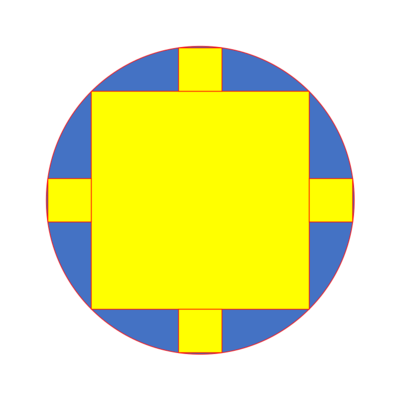Five Squares in a Circle
A square is inscribed in a circle. In each of the four regions bounded by a side of the square and the circle's smaller circular arc joining the endpoints of that side, a square is drawn so that one side of it lies on the side of the larger square and the two opposite vertices lie on the circle, as shown.
Let the ratio of the combined area of all the squares to the area of the circle be b π a , where a and b are coprime positive integers. Find a + b 3 .

The answer is 15683.
This section requires Javascript.
You are seeing this because something didn't load right. We suggest you, (a) try
refreshing the page, (b) enabling javascript if it is disabled on your browser and,
finally, (c)
loading the
non-javascript version of this page
. We're sorry about the hassle.
2 solutions
Lol did the exact same but apparently made some typo, ending up with the wrong answer. I did find a and b. Why wasn't it just a+b?
Let side of large and small squares are l and x respectively, then: l = 2 r r 2 = ( 2 l + x ) 2 + ( 2 x ) 2 r 2 = ( 2 2 r + x ) 2 + ( 2 x ) 2 5 x 2 + 4 2 x r − 2 r 2 = 0 ⟹ x = 5 2 r S s q u a r e s = l 2 + 4 x 2 = 2 5 5 8 r 2 S c i r c l e S s q u a r e s = π r 2 2 5 5 8 r 2 = 2 5 π 5 8 ⟹ a = 5 8 b = 2 5 ∴ a + b 3 = 1 5 6 8 3
Let the radius of the circle be 1 . Then the side length of the big square is 1 2 + 1 2 = 2 . Let the side length of the small square be a . Then we note that
( 2 1 + a ) 2 + ( 2 a ) 2 2 1 + 2 a + a 2 + 4 a 2 4 5 a 2 + 2 a a 2 + 5 4 2 a ( a + 5 2 2 ) 2 a + 5 2 2 ⟹ a = 1 2 = 1 = 2 1 = 5 2 = 5 2 + 2 5 8 = 2 5 1 8 = 5 3 2 = 5 2
Then the ratio of areas π ⋅ 1 2 ( 2 ) 2 + 4 a 2 = π 2 + 4 ⋅ 2 5 2 = 2 5 π 5 8 . Therefore the required answer is 5 8 + 2 5 3 = 1 5 6 8 3 .